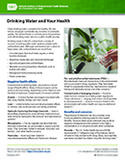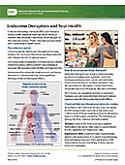Introduction

How Are People Exposed to PFAS?
Human exposure to PFAS is widespread but variable by geography and occupation. PFAS are used in the aerospace, automotive, construction, and electronics industries. Over time, PFAS may leak into the soil, water, and air.
People are most likely exposed to these chemicals by consuming PFAS-contaminated water or food, using products made with PFAS, or breathing air containing PFAS. Because PFAS break down slowly, if at all, people and animals are repeatedly exposed to them, and blood levels of some PFAS can build up over time.
One report by the Centers for Disease Control and Prevention, using data from the National Health and Nutrition Examination Survey (NHANES), found PFAS in the blood of 97% of Americans.1 Another NHANES report suggested blood levels of PFOS and PFOA in people have been reduced since those chemicals were removed from consumer products in the early 2000s. However, new PFAS chemicals have been created and exposure to them is difficult to assess.
NIEHS conducts or funds research that aims to understand more about PFAS exposures and any subsequent health effects.
Why Be Concerned About PFAS?
Multiple health effects associated with PFAS exposure have been identified and are supported by different scientific studies. Concerns about the public health impact of PFAS have arisen for the following reasons:
- Widespread occurrence. Studies find PFAS in the blood and urine of people, and scientists want to know if they cause health problems.
- Numerous exposures. PFAS are used in hundreds of products globally, with many opportunities for human exposure.
- Growing numbers. PFAS are a group of nearly 15,000 synthetic chemicals, according to a chemicals database (CompTox) maintained by the U.S. Environmental Protection Agency.
- Persistent. PFAS remain in the environment for an unknown amount of time.
- Bioaccumulation. People may encounter different PFAS chemicals in various ways. Over time, people may take in more of the chemicals than they excrete, a process that leads to bioaccumulation in bodies.
Because there are many types of PFAS chemicals, which often occur in complex mixtures and in various everyday products, researchers face challenges in studying them. More research is needed to fully understand all sources of exposure, and if and how they may cause health problems.
-
Lewis RC, Johns LE, Meeker JD. 2015. Serum Biomarkers of Exposure to Perfluoroalkyl Substances in Relation to Serum Testosterone and Measures of Thyroid Function among Adults and Adolescents from NHANES 2011â2012. Int J Environ Res Public Health. 12(6): 6098â6114. [Abstract Lewis RC, Johns LE, Meeker JD. 2015. Serum Biomarkers of Exposure to Perfluoroalkyl Substances in Relation to Serum Testosterone and Measures of Thyroid Function among Adults and Adolescents from NHANES 2011â2012. Int J Environ Res Public Health. 12(6): 6098â6114.]
What is NIEHS Doing?
NIEHS supports research to characterize and better understand the possible health effects of exposure to PFAS chemicals.
This work is conducted in three main ways:
- NIEHS funds research grants primarily at universities, but also non-profit research centers and a few small businesses.
- Some NIEHS scientists conduct PFAS research at in-house laboratories.
- NIEHS also collaborates with federal partners.
Current research areas at NIEHS include:
- How, where, and the extent to which people are exposed to PFAS.
- How PFAS can affect organs and systems in the body.
- How and where PFAS move through the environment, such as through water, air, and dust.
- Determining ways to identify, detect, and measure PFAS in the environment.
- Development of technologies and devices to get rid of or destroy PFAS.
- Determining effective ways to tell people about PFAS risk and what they can do to prevent or reduce their exposure.
NIEHS research is used by federal and state regulatory, environmental, and public health agencies to develop new standards to protect the health of people throughout the world. NIEHS is not a regulatory agency.
Other federal agencies, such as EPA and CDC, also conduct research related to PFAS.
PFAS science continues to evolve. There is still much to be learned, particularly in assessing human health effects of exposure to PFAS.
Federal Coordination
NIEHS participates in the government-wide approach led by the White House to advance clean drinking water and reduce pollutants. This collaboration works to identify routes of PFAS exposure, understand associated health risks, and reduce the public’s dietary exposure to PFAS.
What We Have Learned So Far
It is important to note that there are thousands of variations in PFAS chemicals, which can make them hard to study. But the research conducted to date reveals possible links between human exposures to certain PFAS and some adverse health outcomes. These health effects include:
- Altered metabolism and body weight regulation, and risk of childhood obesity.
- Increased risk of some cancers.
- Reduced ability of the immune system to fight infections.
Furthermore, the National Toxicology Program (NTP), an interagency program headquartered at NIEHS, concluded that two types of PFAS, PFOA and PFOS, suppressed the antibody response and were a hazard to immune system function in humans.
NIEHS-funded Research
NIEHS supports more than 40 research groups across the country to better understand the health effects of PFAS. These researchers have established links between exposure to some PFAS and disease, but there is still much to learn.
- Exposure to PFAS may delay the onset of puberty in girls. This study is the first longitudinal research to include the role hormones play in the puberty delay. This delay can lead to negative long-term health outcomes, including a higher incidence of breast cancer, renal disease, and thyroid disease.
- Exposure to PFAS in adolescents was linked to a decrease in bone mineral density over time. Lower bone mineral density can lead to osteoporosis and other bone diseases. This study adds to previous research mostly focused on older populations that has linked PFAS to reduced bone mineral density.
- A long-term study showed a link between PFAS exposure and increased risk of Type 2 diabetes in women.
- Studies show folate may reduce PFAS accumulation in the body, which may protect against adverse birth outcomes and boost immune health.
- A high-fiber diet may decrease metabolic disease risks associated with exposure to PFOS, a type of PFAS. Although PFOS use has been phased out, it can still be found in drinking water, groundwater, soil, and air.
- Exposure to certain PFAS may be associated with increased risk of thyroid cancer.
- A large-scale study on exposure to PFAS in humans and rodents showed consistent evidence of liver damage. PFAS are known to accumulate in body tissues such as in the liver. Nonalcoholic fatty liver disease is a fast-growing epidemic in the U.S. that cannot be fully explained by commonly understood risk factors such as sedentary lifestyle, genetics, and diet. This situation led researchers to investigate environmental exposures, such as PFAS, and liver disease.
The NIEHS Superfund Research Program (SRP) funds the search for practical applications to protect the public from exposures to hazardous substances. Examples include:
- The Sources, Transport, Exposure, and Effects of PFASs (STEEP) project, at the University of Rhode Island, is identifying sources of PFAS contamination, assessing human health effects, and educating communities on ways to reduce exposure.1
- The Michigan State Superfund Research Center is developing energy-efficient nanoreactors capable of breaking the carbon-fluorine bond that keeps PFAS from degrading.
- Scientists at the University of California, Berkeley, are working on options to contain aqueous film-forming foams used for firefighting, a major source of PFAS contamination.
- The Brown University Superfund Research Center has developed databases that exploit land use data to identify cities and towns at high risk for PFAS exposure.2
- Small Business Innovation Research (SBIR) grantee CycloPure, Inc., has developed a new way to remove hazardous PFAS from water. The water pitcher-based filters should be an affordable option for people concerned about PFAS exposure where they live or work.
- A team at the North Carolina State University SRP Center is studying alligators living in PFAS-contaminated water to understand possible effects on the immune system. They also developed a new high-throughput tool to quickly characterize how PFAS may be transported within the body and potentially cause harm.
- Another SBIR project by EnChem Engineering, Inc. is developing an innovative technology to speed up removal of PFAS at Superfund sites.
- SRP-funded small business AxNano developed a portable tool that relies on nanoparticles to quickly detect PFAS in samples. Their method is more affordable and efficient than traditional mass spectrometry.
-
STEEP: Sources, Transport, Exposure, & Effects of PFASs. [Accessed 25 February 2019] [Available STEEP: Sources, Transport, Exposure, & Effects of PFASs. [Accessed 25 February 2019]]
-
Guelfo JL, Adamson DT. Evaluation of a national data set for insights into sources, composition, and concentrations of per- and polyfluoroalkyl substances (PFASs) in U.S. drinking water. 2018. Environ Pollut. 236:505-513. [Online 1 May 2018] [Abstract Guelfo JL, Adamson DT. Evaluation of a national data set for insights into sources, composition, and concentrations of per- and polyfluoroalkyl substances (PFASs) in U.S. drinking water. 2018. Environ Pollut. 236:505-513. [Online 1 May 2018]]
Further Reading
Stories from the Environmental Factor (NIEHS Newsletter)
- Researchers Investigate a New Method to Detect PFAS Chemicals (May 2025)
- Cancer Causes Attributable to PFAS in Drinking Water (February/March 2025)
- PFAS Mixtures More Harmful to Health Than Exposure to a Single Compound (December 2024)
- Water Treatment Technology Aims to Destroy PFAS On-site (November 2024)
- Evaluating the Effect of PFAS on Liver Cells (November 2024)
- PFAS Chemicals, Other Resources Added to Toxicity Testing Tool (September 2024)
- Ask the Expert: How Does NIEHS Research on PFAS Affect Me? (May 2024)
- New Strategy To Prioritize PFAS for Health Risk Assessments (May 2024)
- Researchers Team up With Tribe, Community to Fight PFAS With Plants (April 2024)
- For PFAS-Polluted Sites, Forum Highlights Best Research Practices (December 2023)
- High-fiber Diet May Protect Against Exposure to PFOS(April 2023)
- Alligators Exposed to Elevated Levels of PFAS Show Signs of Immune Disruption (December 2022)
- Liver Injury Linked to PFAS Exposures, NIEHS Grantee Says(October 2022)
- Plant-based Material Can Remediate PFAS, New Research Suggests(September 2022)
- NIEHS Influences National Efforts to Understand, Solve PFAS Problems (September 2022)
- PFAS Water Filter Developed Through NIEHS Funding (April 2022)
Additional Resources
- FDA Announcements on PFAS - FDA works to better understand PFAS exposure in the U.S. by testing the general food supply, including bottled water. The results of this testing and any regulatory actions taken are summarized and posted throughout the year.
- National Academies Sciences Engineering Medicine Consensus Study Report Highlights - Guidance on PFAS Exposure,Testing, and Clinical Follow-Up. NIEHS, and the Agency for Toxic Substances, and Disease Registry (ATSDR) supported this study to evaluate the most current evidence on the human health effects associated with PFAS exposure and to provide information for ATSDR to consider in their advice for clinicians about PFAS testing and how test results should inform clinical care.
- PFAS Blood Testing: What You Need to Know - this fact sheet was created, in 2022, by a NIEHS-funded project at the Silent Spring Institute.
- PFAS Collection 2022 - Published between 2018 and 2022, these Environmental Health Perspectives papers demonstrate the diverse areas where skillfully designed PFAS-related epidemiological research and modeling is occurring.
- PFAS Contamination Map - A nationwide map of PFAS contamination was created by the Environmental Working Group.
- PFAS Exchange - The Silent Spring Institute provides many fact sheets and other resources to help you protect your health.
- PFAS Strategic Roadmap: EPA's Commitments to Action 2021-2024 - PFAS contamination poses unique challenges. The actions outlined in the roadmap may lead to more enduring and protective solutions.
- Reducing PFAS in Drinking Water (1MB) - In the Cincinnati area, NIEHS-funded researchers discovered high levels of a specific PFAS chemical, called perfluorooctanoate (PFOA), in young girls. This research translation story shows how they worked with local water departments to implement water filtering techniques that resulted in a 40-60% reduction in PFOA levels in the girls and other residents.
Related Health Topics
This content is available to use on your website.
Please visit NIEHS Syndication to get started.



